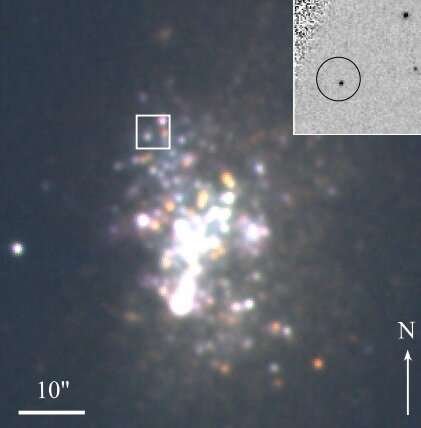November 29, 2019 report
Ultraluminous X-ray source UGC 6456 ULX investigated in detail

Russian astronomers have performed a detailed study of one of the ultraluminous X-ray sources (ULXs) in the galaxy UGC 6456. Results of the research, presented in a paper published November 20 on arXiv.org, suggest that this source, designated UGC 6456 ULX, is one of the brightest known ULXs in the optical range.
ULXs are point sources in the sky that are so bright in X-rays that each emits more radiation than 1 million suns emit at all wavelengths. They are less luminous than active galactic nuclei, but more consistently luminous than any known stellar process. Although numerous studies of ULXs have been conducted, the basic nature of these sources still remains unsolved.
At a distance of about 14.8 million light years away, UGC 6456 is one of the closest blue compact dwarf galaxies. It hosts the UGC 6456 ULX—a transient source not well studied, whose properties remain undisclosed.
Now, a team of astronomers led by Alexander Vinokurov of Special Astrophysical Observatory in Nizhnij Arkhyz, Russia, reports a new study of UGC 6456 ULX, which identified an optical counterpart of this ULX and shed more light on the parameters of this source. The research was based mainly on the analysis of archival images of UGC 6456 ULX obtained with Chandra X-Ray Observatory and the Hubble Space Telescope (HST).
"We present preliminary results of a study of the ultraluminous X-ray source UGC 6456 ULX. (...) To identify an optical counterpart of UGC 6456 ULX, we used archival images from Chandra X-Ray Observatory and HST," the astronomers wrote in the paper.
According to the study, UGC 6456 ULX showcases luminosity changes by more than two orders of magnitude with a peak value of 17 duodecillion erg/s in the 0.3–8 keV energy range. The absolute magnitude of this source in the bright state exceeds −7.6, which makes it one of the brightest ULXs in the optical range so far identified.
The research found that UGC 6456 ULX exhibits high optical and X-ray variability, however the nature of such behavior is uncertain and requires further studies. The astronomers noted that the variability of this source has an amplitude similar to that observed in NGC 7793 P13—a well studied ULX with a neutron star.
Moreover, the study reports a correlation between the optical and X-ray fluxes in UGC 6456 ULX. This may indicate that the optical emission from this source is produced by re-processing of the X-rays in outer parts of the optically-thick wind. According to the researchers, the detection of broad and variable hydrogen as well as helium emission lines supports the scenario of a strong wind coming from the supercritical accretion disk.
"The existence of such a wind is confirmed by the presence of the wide hydrogen and helium emission lines in the optical spectra, that are typical for the all spectroscopically studied ULXs," the authors of the paper concluded.
More information: The study of ultraluminous X-ray source UGC 6456 ULX, arXiv:1911.09043 [astro-ph.HE] arxiv.org/abs/1911.09043
© 2019 Science X Network



















